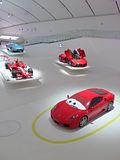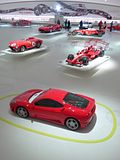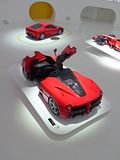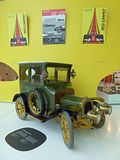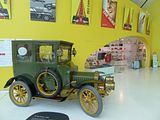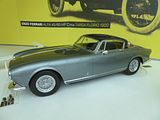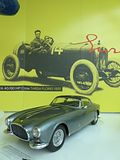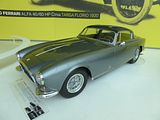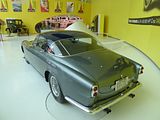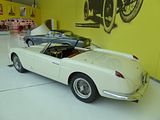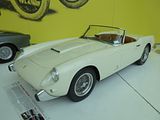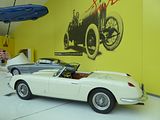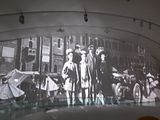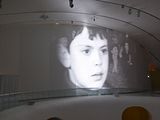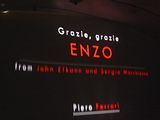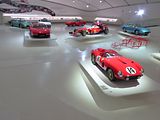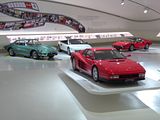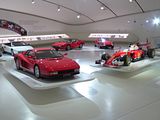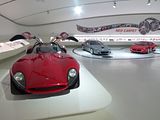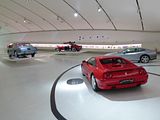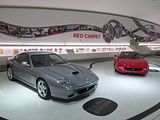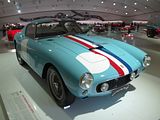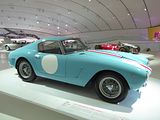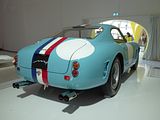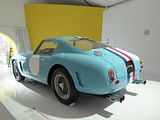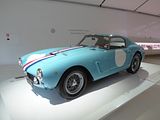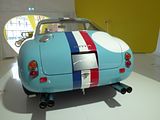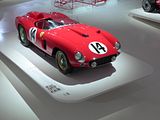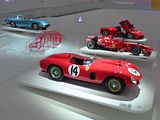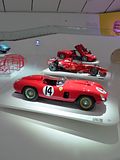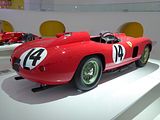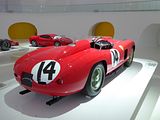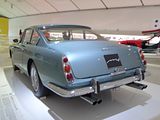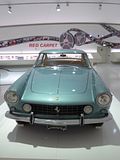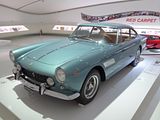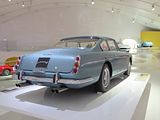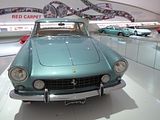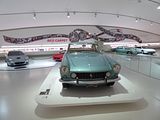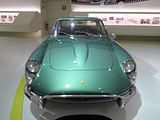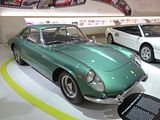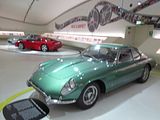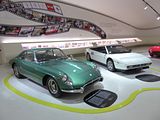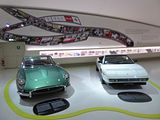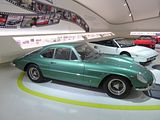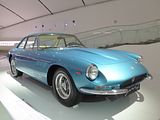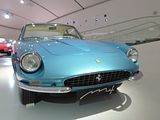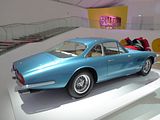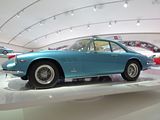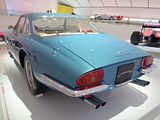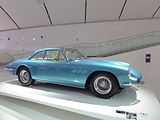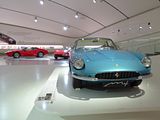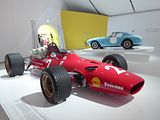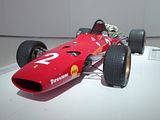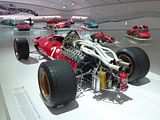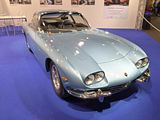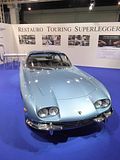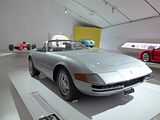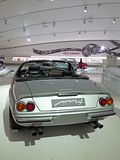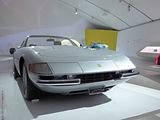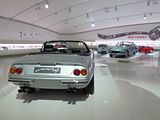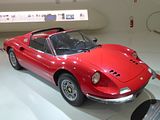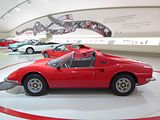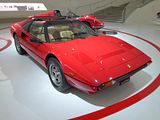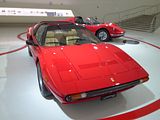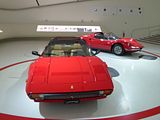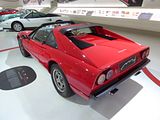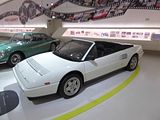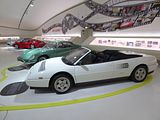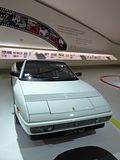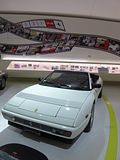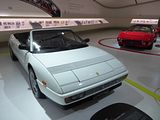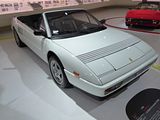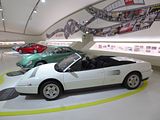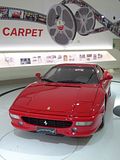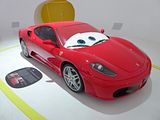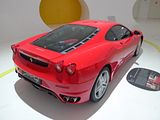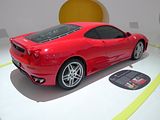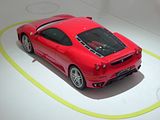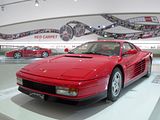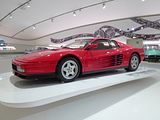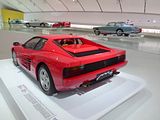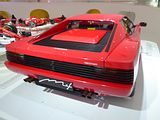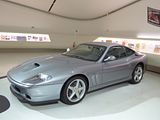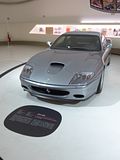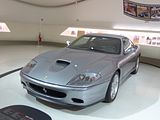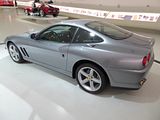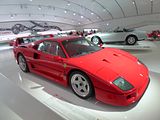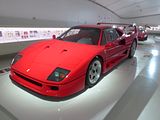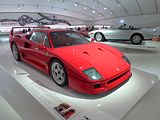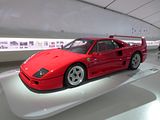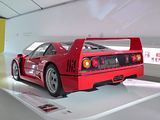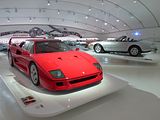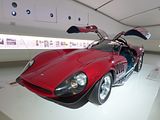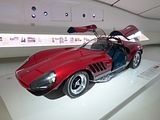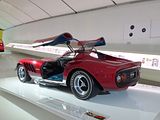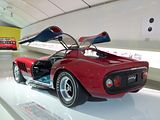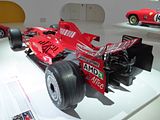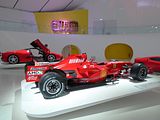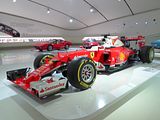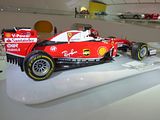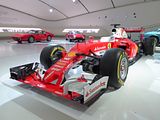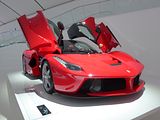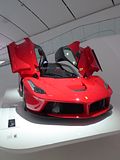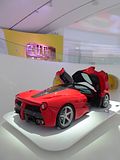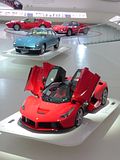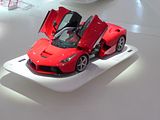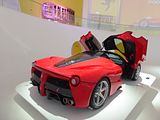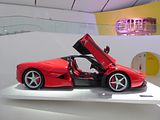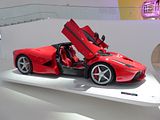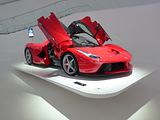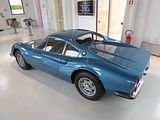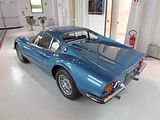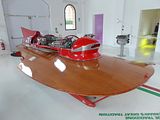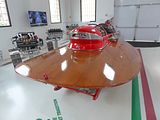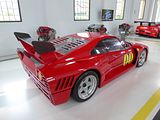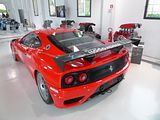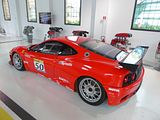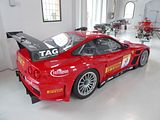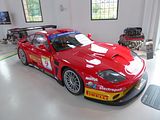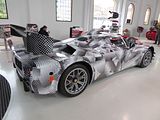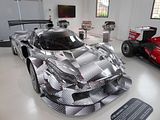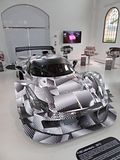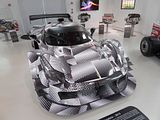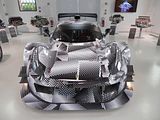Before you enter the main display area, there is an expansive foyer, with a Cafe at one end. At the other, to the right of the entrance to the main display, there is space for three cars to be displayed and here they are:
This little 1903 De Dion Bouton is particularly significant as it belonged to the Ferrari family and in an era when cars were few and far between, would have been one of the inspirations for the young Enzo and his early interest in the automobile. Its 942cc engine generated 8HP which was enough to allow the car to reach 60 km/h.
The 375 America was introduced in 1953 and a Pinin Farina bodied example was shown at that year’s Paris Salon. Built as a successor to the 342 America, The 375 used the new 4.5 litre “long block” Lampredi designed V12 engine that produced up to 300 PS (296 hp) at 6500 rpm and allowed it do 0-60 mph in under seven seconds and reach a top speed of almost 160 mph. The 375 and later used odd chassis numbering of a road cars, while the 340/342 Americas using even chassis numbering of a race cars. The 375 was expensive and exclusive and was only built from late 1953 through 1954. 12 cars were made, with ten being original 375s and two being 250 Europas that were subsequently converted to 375 specifications (the 250 Europa and 375 had a nearly identical wheelbase). The majority of 375s had either three or five-window coupe bodies by Pinin Farina, though Vignale bodied around three Coupés and one convertible.
Third of the trio was a 250 GT Cabriolet Spider. Designed for export to North America, the 1957 250 GT California Spyder was Scaglietti’s interpretation of an open-top 250 GT. Aluminium was used for the bonnet, doors, and boot lid, with steel elsewhere for most models. Several aluminium-bodied racing versions were also built. The engine was the same as in the 250 Tour de France racing car with up to 240 PS @ 7000 rpm and a maximum torque of 195 lb/ft @ 5000 rpm, from a 2,953 cc naturally aspirated SOHC 2 valves per cylinder 60º Ferrari Colombo V12 engine, equipped with 3 Weber carburettors. All used the long 2,600 mm (102.4 in) chassis, and Pirelli Cinturato 185VR16 tyres (CA67) were standard. A total of fifty LWBs were made before the SWB version superseded them in 1960. One example sold at auction on August 18, 2007 in Monterey, California, for $4.9 million.
Depending on when you arrive, you may have to wait a few minutes for entry.The reason for this is because about every 30 minutes, the lights dim, and a video is projected on the wall above the main entrance. It lasts about 10 minutes and covers the life of Enzo Ferrari and his legacy with some wonderful periodic footage. Needless to say the climax has the audio backing of Luciano Pavarotti singing Puccini’s famous “Nessum Dorma”. It is impossible not to be moved as the video reaches its climax saying “Grazie Enzo”. I’ve seen it several times now, and it still moves me greatly.
You enter the display in the top corner and can get some great perspectives of the cars that are in the centre of the museum. There are cabinets around the side of the building, with all manner of period material that contains fascinating insights into the history of the Ferrari company and were you to study them all, then your visit would take many hours. Most people it would seem take a cursory glance at a few of them, wander around the cars, take photos – often, I suspect, more interested in the selfie aspect than the car itself! – and then leave. I stayed for a couple of hours, just taking it all in, and waiting patiently to get some shots which only had cars, and no people in them. These are the cars that I saw, presented in no particular order.
Probably the most valuable car of the lot was actually the first one that I came to, a 1959 Ferrari 250 GT SWB (Passo Corto). One of the better known early Ferraris, examples of this model are to be seen at historic motor racing events as well as concours events. First seen in 1959, the 250 GT Berlinetta SWB used a short 2,400 mm (94.5 in) wheelbase for better handling. Of the 176 examples built, both steel and aluminium bodies were used in various road (“lusso”) and racing trims. Engine output ranged from 237 bhp to 276 bhp. Development of the 250 GT SWB Berlinetta was handled by Giotto Bizzarrini, Carlo Chiti, and young Mauro Forghieri, the same team that later produced the 250 GTO. Disc brakes were a first in a Ferrari GT, and the combination of low weight, high power, and well-sorted suspension made it a competitive offering. It was unveiled at the Paris Motor Show in October and quickly began selling and racing. The SWB Berlinetta claimed GT class of the Constructor’s Championship for Ferrari in 1961. These cars are highly prized nowadays and for good reason.
The Ferrari 290 MM was a race car produced in 1956, developed to compete in the 1956 edition of Mille Miglia, hence the acronym “MM”, and four cars were built. The 290 MM was powered by a 3.5 litre, 60° V12 derived from the 4.5-litre unit which at the time was used in Ferrari’s Formula One cars. Displacement was 3,490 cc with a maximum power of 320 HP at 7200 rpm, and a top speed of 280 km/h (170 mph). The car won the 1956 Mille Miglia, raced by Eugenio Castellotti, while another 290 MM, driven by Juan Manuel Fangio, finished fourth. Phil Hill and Maurice Trintignant also won the Swedish Grand Prix of that year, granting Ferrari the overall victory in the World Sportscar Championship. The following year a 290 MM won the 1000 km Buenos Aires. On December 10, 2015, RM Sotheby’s sold the one driven by Juan Manuel Fangio in the 1956 Mille Miglia at auction for $25,050,000 — the highest price for a car sold in 2015; the highest price ever paid for a racing car and the third most expensive ever.
No fewer than 18 different models were made with the 250 designation, with new versions being seen every few months. The LWB 250 GT theme was expanded with a 2+2 model called the 250 GT/E. The first large production four-seat Ferrari (earlier four seaters were made in very small numbers), this model offered greater interior space by moving the engine forward in the chassis. The rear seats were ideal for children but rather tight for adults. Engine output was listed at 237 bhp, making it a very rapid four seater indeed. Almost 1,000 GT/Es were constructed by Pininfarina with prototypes starting in 1959 and continuing through three series until 1963. The model was followed by the visually similar 330 Americas. The large production run of the GT/E was a major contributor to the financial well being of Ferrari in the early 1960s. In recent times many of them have had their bodies removed, so the chassis can be used for replica versions of other models from the 250 lineup, but people are now realising that these cars are attractive in their own right and the trend appears to have stopped.
This is a 400 Superamerica, which had a smaller 4.0 litre V12 Colombo engine, but produced as much power as its predecessor. It debuted in 1959 as 410 production ended, and was available as a coupe, spider, or cabriolet with custom Pinin Farina bodywork. Four-wheel disc brakes were a new addition. 47 Ferrari 400s had been built, in two distinct 2 series, when the 400 stepped aside in 1964, of which 32 were coupé aerodinamico variant. Series I coupés aerodinamico had open bonnet air scoop while series II cars had covered scoop and slightly longer wheelbase.
Next of the exclusive road cars was a 1964 500 Superfast, one of a series of Ferrari models which are sometimes known as Ferrari America, as the inspiration to produce them came from America, as indeed did many of the initial customers, and some of them had America in their title. The 500 Superfast was really the end of this line, although it was followed by the 14 examples of the 365 California Spider which were built in 1967. Early in development, and even into production, these cars were to be called “Superamericas”, but the decision was made at the last moment to use “Superfast” instead. The engine was a 5.0 litre Ferrari Colombo V12 engine, generating 395 hp, making the car capable of 280 km/h (174 mph). The engine had the same dimensions as the Lampredi “long-block” engines of the 410 Superamerica, otherwise the design was based on the original Colombo ‘short’ block. The chassis was very similar in construction to the contemporary 330 GT 2+2, and bodywork was again done by Pininfarina. When leaving the factory, the 500 Superfast originally fitted Pirelli Cinturato 205VR15 tyres (CN72). 36 cars were made to 1966, including 12 “series II” models with an updated 5-speed transmission. Production total excludes a one-off 330 GT 2+2 produced with a Superfast-style body for HRH Prince Bernhard of The Netherlands. Only coupes were made and no Superfast roadsters were available. Needless to say, it was very costly when new, listing for more than twice the price of a Rolls Royce. Among the first owners were the Shah of Iran and Peter Sellers.
First of the Grand Prix cars in the display was this 1967 312-T. The Ferrari 312 was the designation of the 3 litre V-12 (hence 312) Formula One cars raced by the Italian team from 1966 to 1969. Designed under the leadership of Mauro Forghieri, there were two distinct variations using this designation, the 1966 version and the completely different 1967-69 version. The ’66 cars carried on the chassis numbering sequence from the previous year’s 1.5 litre cars, while the ’67 cars began a new sequence at “0001”. To avoid confusion, the cars are commonly referred to as 312/66, 312/67 etc. For the 1966 Formula One season, there was a change in the technical regulations, now allowing 3 litre engines. The F1 teams, even though asking for “the return to power”, were more or less surprised and not well prepared. Ferrari’s first 1966 car consisted of a 3.3-litre V12 engine that was taken from the Ferrari 275P2 sportscar prototypes, modified to 3000cc, and mounted in the back of an F1 chassis. The designation 312, which would be used for a number of later cars, indicated a 3-litre, 12-cylinder engine. The engine was rather heavy, and due to the reduced capacity, lower on power and especially torque. John Surtees drove this contraption unsuccessfully in Monaco while Lorenzo Bandini drove a Ferrari Dino 2.4-litre V6. Surtees won the second race, the 1966 Belgian Grand Prix, a track that favoured power with its long straights, but the 1964 champion departed after a row with manager Eugenio Dragoni. The issue was about priorities in racing, as Ferrari was under pressure from Ford in sports car racing, and the F1 effort was somewhat neglected. Mike Parkes replaced Surtees, who went to Cooper which used Maserati engines, to finish second in the driver championship with a further win. For Ferrari, Ludovico Scarfiotti also won a race, the 1966 Italian Grand Prix at Monza which helped Ferrari finish second in the Constructors’ Championship. In 1967, the team fired Dragoni and replaced him with Franco Lini. Chris Amon partnered Bandini to drive a somewhat improved version of the 1966 V12 car. At the 1967 Monaco Grand Prix, Bandini crashed and suffered heavy injuries when he was trapped under his burning car; several days later he succumbed to his injuries. Ferrari re-hired Mike Parkes, but Parkes suffered career-ending injuries weeks later at the 1967 Belgian Grand Prix. A fatal crash, another bad crash, no race win, and only 5th in the Constructors’ Championship marked a bad year for the Italians. In addition, the new Ford Cosworth DFV engine that had its debut in the Lotus 49 would dominate F1 in the 15 years to come. The 1968 season was little better. Young talent Jacky Ickx won the wet 1968 French Grand Prix with his driving skills, but had few other successes. Things became more complicated during the season by the introduction of aerodynamic aids into F1, and their quick development. At the end of the season, the Scuderia Ferrari was only 4th in the Constructors’ Championship, and there was also no success in sportscar racing as Ferrari did not take part at all in 1968. Manager Franco Lini quit, and so did Ickx, moving to Brabham. To provide for the future, during the summer of 1968, Ferrari worked out a deal to sell his road car business to Fiat for $11 million; the transaction took place in early 1969, leaving 50% of the business still under control of Ferrari himself. During 1969 Enzo Ferrari set about wisely spending his new-found wealth to revive his struggling team; though Ferrari did compete in Formula One in 1969, it was something of a throwaway season while the team was restructured. Amon continued to drive an older model and Pedro Rodríguez took Jacky Ickx’s place; at the end of the year Amon left the team which once again had no race wins and was only ranked 5th in the Constructors’ Championship. The car was succeeded by the 312B which was introduced for the 1970 Formula One season.
There was one interloper in the display, a Lamborghini 400GT. The first 400 GTs were essentially just the older 350GT featuring an enlarged, 3929 cc V12 engine, with a power output of 320 bhp and recognised by the change to twin circular headlights from rectangular units. Twenty-three of these cars were built, with three featuring aluminium bodywork, and then at the 1966 Geneva Show, Lamborghini presented a revised version, called the 400 GT 2+2, which had a different roofline, and minor sheetmetal changes compared to the earlier cars, still with the Carrozzeria Touring bodywork. The larger body shape enabled the +2 seating to be installed in the rear, where the 350GT only had room for luggage or +1 seating, without changing the wheelbase. The 400 GT 2+2 also had a Lamborghini designed gearbox, with Porsche style synchromesh on all gears, which greatly improved the drivetrain. 224 examples of the 400 GT 2+2 were built from 1966 to 1968, when it was replaced with the Islero.
The Ferrari 365 GTB/4 Daytona probably needs little introduction. A Gran Turismo automobile produced from 1968 to 1973, it was first introduced to the public at the Paris Auto Salon in 1968 and replaced the 275 GTB/4. The Daytona was replaced by the mid-engined 365 GT4 Berlinetta Boxer in 1973. Early cars, such as this 1970 example had the plexi-glass front end, before a revised design with pop-up headlights was adopted. The generally accepted total number of Daytonas from the Ferrari club historians is 1,406 over the life of the model. This figure includes 158 right-hand-drive coupés, 122 factory-made spyders (of which 7 are right hand drive), and 15 competition cars in three series with modified lightweight bodies and in various degrees of engine tune. All bodies except the first Pininfarina prototype were produced by Scaglietti.
There were a number of the “entry level” Ferrari models showing a progression from the late 1960s to more recent times. Oldest of these was a 246 GTS Dino. The Ferrari Dino was created to honour Alfredo ‘Dino’ Ferrari, Enzo Ferrari’s only legitimate son, who sadly died of muscular dystrophy in 1956. Unlike any previous road-going Ferrari, the Dino utilised a V6 engine, the Tipo 156, which Alfredo himself had helped develop and strongly advocated during his working life. Following continued motor racing success and in order to homologate Ferrari’s 1966 Formula Two campaign, a new line of mid-engined production V6 coupés with Fiat running gear went on sale in 1967 in two litre 206 GT form. However, in 1969 a larger 2.4 litre Dino was introduced, named the 246 GT or GTS in the case of the Spider. Only 3,913 definitive Dinos were built before the introduction of the completely restyled V8 engined 308 in 1973. The voluptuous bodywork of the 246, which many regard as the prettiest ever to grace a road-going Ferrari, was designed by Pininfarina and built by Scaglietti. It clothed a tubular chassis which carried wishbone independent suspension at each corner. The compact four-cam, 190bhp engine was mounted transversely above the five-speed gearbox and just ahead of the rear axle, allowing for both a comfortable cockpit and some usable boot space.
Selected for inclusion in the display thanks to its starring role in Magnum PI, was this 308 GTS. The 308 GTB was launched at the Paris Motor Show in 1975 as a direct replacement for the Dino 246. Designed by Pininfarina with sweeping curves and aggressive lines, the 308 has gone on to become one of the most recognised Ferraris of all time. Fitted with a 2.9 litre DOHC V8 engine fed by four Webber 40DCNF Carburettors, the power output of 255bhp was sufficient to propel the 308 from 0 to 60mph in 6.5 seconds and on to a top speed of 159 mph.Tougher emissions standards in the 1980s challenged Ferrari more than many other marques. In 1980, fuel injection was adopted for the first time on the 308 GTB and GTS models, and power dropped quite noticeably fro 240 bhp to 214bhp. Two years later, at the 1982 Paris Motor Show, Ferrari launched the 308 quattrovalvole, in GTB and GTS form. The main change from the 308 GTBi/GTSi it succeeded were the 4-valves per cylinder—hence its name, which pushed output back up to 240 hp restoring some of the performance lost to the emission control equipment. The new model could be recognised by the addition of a slim louvred panel in the front lid to aid radiator exhaust air exit, power operated mirrors carrying a small enamel Ferrari badge, a redesigned radiator grille with rectangular driving lights on each side, and rectangular (in place of round) side repeaters. The interior also received some minor updates, such as a satin black three spoke steering wheel with triangular centre; cloth seat centres became available as an option to the standard full leather. Available included metallic paint, a deep front spoiler, air conditioning, wider wheels, 16-inch Speedline wheels with Pirelli P7 tyres, and a satin black roof aerofoil (standard on Japanese market models). Apart from the 32-valve cylinder heads, the V8 engine was essentially of the same design as that used in the 308 GTSi model. The gear and final drive ratios were altered to suit the revised characteristics of the four valves per cylinder engine. One other significant benefit of the QV four valve heads was the replacement of the non-QV models sodium valves which have been known to fail at the joint between the head and the stem. Bosch K-Jetronic fuel injection and Marelli Digiplex electronic ignition were carried over from the GTBi/GTSi. The car was produced in this form until the launch of the 328 models in the autumn of 1985 which had larger 3.2 litre engines and a number of styling changes. 308 GTB models are becoming increasingly sought after, with prices rising steadily and quite steeply.
Produced alongside the 308/328 GTB and GTS models was the Mondial, and there were a couple of examples of the car on show. Produced by Ferrari from 1980 through 1993, it replaced the 208/308 GT4. The “Mondial” name came from Ferrari’s history — the 500 Mondial race car of the early 1950s. Despite its predecessor being Bertone styled, the Mondial saw Ferrari return to Pininfarina for styling. Sold as a mid-sized coupe and, eventually a cabriolet, it was conceived as a ‘usable’ model, offering the practicality of four seats and the performance of a Ferrari. The car had a slightly higher roofline than its stablemates, with a single long door either side, offering easy access and good interior space, reasonable rear legroom while all-round visibility was excellent. The cabriolets also hold the distinction of being the only production automobile in history that has four seats, is rear mid-engined, and is a full convertible. The car body was not built as a monocoque in the same way as a conventional car. The steel outer body produced by the famous Italian coachbuilder Carrozzeria Scaglietti, in nearby Modena, was built over a lightweight steel box-section space frame. The engine cover and rear luggage compartment lids are in light alloy. The seats and interior were trimmed in Connolly hide, contrasting with the body colour. Most cars were painted rosso red, but some were black or silver, and a few were dark blue. The Mondial was the first Ferrari car where the entire engine/gearbox/rear suspension assembly is on a detachable steel subframe. This design made engine removal for a major rebuild or cylinder head removal much easier than it was on previous models. Unusually, the handbrake is situated between the driver’s seat and the inner sill. Once the handbrake is set it drops down so as, not to impede egress and ingress. Instead of the conventional “H” shift pattern, the gearbox has 1st gear situated in a “dog leg” to the left and back, behind reverse. This pattern, otherwise known as a “reverse h-gate”, allows quicker gear shifts between 2nd and 3rd gear, and also between 4th and 5th. The Mondial underwent many updates throughout production. There were four distinct iterations (8, QV, 3.2, and t), with the latter 3 having two variations each. (coupe and cabriolet). The first car was introduced as the Mondial 8 at the 1980 Geneva Auto Salon. It was the first Ferrari to depart from the company’s simple 3-digit naming scheme, and some reviews found it relatively mild, compared to other Ferraris, regarding performance, drawing criticism from some in the motoring press. It used a mid/rear-mounted Bosch K-Jetronic fuel injection V8, shared with the 308 GTBi/GTSi, mounted transversely. The engine used in the 1973 Dino 308 GT4. The K-Jetronic system is mechanical, with a high-pressure pump which streams fuel continuously to the injectors; it does not have a computer, just a few relays to handle the cold start sequence etc. The chassis was also based on the 308 GT4, but with a 100mm (3.9 inch) longer wheelbase at 2,650 mm (104.3 in). The suspension was the classic layout of unequal-length double wishbones and Koni dampers all around. Today, the Mondial 8 is considered one of the marque’s most “practical” vehicles, due to its 214 hp, proven drivetrain, four seats, and relatively low cost of maintenance (major services can be performed without removing the entire engine/transmission subframe). 703 examples were made. The first Mondial engine, although a DOHC design, used just two valves per cylinder. The 1982 Quattrovalvole or QV introduced a new four-valve head; the combustion chamber design purportedly based on the early eighties Formula 1 engine. Again, the engine was shared with the contemporary 308 GTB/GTS QV, and produced a much more respectable 240 hp. Appearance was largely as per the Mondial 8, although with red engine heads and prominent “quattrovalvole” script at the rear. 1,145 coupés built between 1982 and 1985. A new Cabriolet body style added for 1983. Body styling remained the same as the coupé variant, with the roof maintaining the ‘buttress’ design of the roof, though the Cabriolet required the rear seats to be mounted closer together laterally. The introduction of the Cabriolet saw the popularity of the Mondial rise, particularly in the American market, where the convertible body style was highly desirable. The Cabriolet has the added distinction of being the only four-seat, mid-rear engine, convertible automobile ever manufactured in regular production. 629 units were produced between 1983 and 1985, making this the rarest version of the Mondial. Like the Ferrari 328, the Mondial’s engine grew in both bore and stroke to 3,185 cc in 1985. Output was now 270 PS. The Mondial 3.2 was first presented at the 1985 Frankfurt Auto Show in September that year. Available in both Coupé and Cabriolet forms, styling refreshed with restyled and body-coloured bumpers, similar to the 328 with more integrated indicators and driving lamps, and new alloy wheels with a more rounded face. The 3.2 also boasted a major interior update, with a more ergonomic layout and a more rounded instrument binnacle. Later cars, from 1987 onwards, also sported ABS brakes. Fuel injection remained the primarily mechanical Bosch K-Jetronic (CIS) with an O2 sensor in the exhaust providing feedback to a simple computer for mixture trimming via a pulse modulated frequency valve that regulated control fuel pressure. The ignition system was Marelli Microplex, with electronic advance control and one distributor per bank of the V8. The 1988 Mondial 3.2 would be the final model year that retained the relatively low maintenance costs of the 308/328 drivetrain, allowing major service items like timing belt and clutch replacement performed with the engine/transmission package still in the car. The final Mondial evolution was 1989’s Mondial t, which was a substantially changed model. It was visually different from preceding Mondial models, the most recognizable being the redesign of the air intakes to a smaller rectangular shape. Additionally, the door-handles were of a visually different design, as were the front and rear bumpers which became body coloured. New front and rear wings cover wider tracks and are re-profiled to a fuller shape compared to previous models, which feature a rolled lip. The ‘t’ called attention to the car’s new engine/transmission layout: the previously-transverse engine mounted longitudinally while the gearbox remained transverse, thus forming a ‘t’. By adopting this layout, a longer engine could be mounted lower in the chassis, improving handling dramatically. The ‘t’ configuration was used by Ferrari’s Formula One cars of the 1980s, and would be the standard for the marque’s future mid-engined V8 cars, beginning with the 348, introduced later in the year. The transverse manual gearbox fitted with a Limited Slip Differential with a twin-plate clutch design with bevel gears driving the wheels. Later in production, a Semi-automatic transmission termed “Valeo” was available as an option; while shifting was using a traditional gear lever, the clutch was actuated automatically without a clutch pedal. The engine was up to 3405 cc and 300 hp, controlled by Bosch Motronic DME 2.5 (later DME 2.7) electronic engine management that integrated EFI and ignition control into a single computer unit. Two of these used in the car: one for each bank of the engine. Engine lubrication upgraded to a dry-sump system. The Mondial’s chassis would underpin a new generation of 2-seat Ferraris, right up to the 360, but the 2+2 Mondial would end production just four and a half years later in 1993. However, the “t” layout of the engine and transaxle, adapted from Ferrari’s Formula One cars, continues to be used in mid-engined V8 model Ferraris to date, albeit with a more sophisticated chassis. The new layout saw the engine and transmission mounted on a removable subframe; the assembly removed from the underside of the vehicle for maintenance. This process is necessary for timing belt replacement, making this a costly procedure for the owner who does not have a lift. On the other hand, the clutch was now located at the very rear of the drive train. This arrangement makes clutch replacement and service a simple, inexpensive, and readily owner-do-able proposition. The “t” was home to other Ferrari firsts: It used power assisted steering for the first time and had a 3-position electronically controlled suspension for a variable tradeoff between ride quality and road holding. It also had standard ABS. Total production of the t Coupe was 858 (45 Right Hand Drive), and the t Cabriolet of 1,017 (51 Right Hand Drive, meaning that around 6000 Mondial cars were produced over those 13 years, making it one of the most commercially significant Ferraris to date.
Launched in May 1994 as an evolution of the Ferrari 348, just about everything was changed, and improved for the F355, seen here in Berlinetta formats. Design emphasis for the F355 was placed on significantly improved performance, but driveability across a wider range of speeds and in different environments such as low-speed city traffic was also addressed, as the Honda NS-X had proved that you could make a supercar that could be lived with every day. Apart from the displacement increase from 3.4 to 3.5 litres, the major difference between the V8 engine in the 348 and F355 was the introduction of a 5-valve cylinder head. This new head design allowed for better intake permeability and resulted in an engine that was considerably more powerful, producing 375 hp. The longitudinal 90° V8 engine was bored 2mm over the 348’s engine, resulting in the small increase in displacement. The F355 had a Motronic system controlling the electronic fuel injection and ignition systems, with a single spark plug per cylinder, resulting in an unusual 5 valves per cylinder configuration. This was reflected in the name, which did not follow the formula from the previous decades of engine capacity in litres followed by number of cylinders such as the 246 = 2.4 litres and 6 cylinders and the 308 of 3.0 litres and 8 cylinders. For the F355, Ferrari used engine capacity followed by the number of valves per cylinder (355 = 3.5 litres engine capacity and 5 valves per cylinder) to bring the performance advances introduced by a 5 valve per cylinder configuration into the forefront. 5. The frame was a steel monocoque with tubular steel rear sub-frame with front and rear suspensions using independent, unequal-length wishbones, coil springs over gas-filled telescopic shock absorbers with electronic control servos and anti-roll bars. The car allows selection between two damper settings, “Comfort” and “Sport”. Ferrari fitted all road-going F355 models with Pirelli tires, size 225/40ZR 18 in front and 265/40 ZR 18 in the rear. Although the F355 was equipped with power-assisted steering (intended to improve low-speed driveability relative to the outgoing 348), this could optionally be replaced with a manual steering rack setup by special order. Aerodynamic designs for the car included over 1,300 hours of wind tunnel analysis. The car incorporates a Nolder profile on the upper portion of the tail, and a fairing on the underbody that generates downforce when the car is at speed. These changes not only made the car faster but also much better to drive, restoring Ferrari to the top of the tree among its rivals. At launch, two models were available: the coupe Berlinetta and the targa topped GTS, which was identical to the Berlinetta apart from the fact that the removable “targa-style” hard top roof could be stored behind the seats. The F355 would prove to be last in the series of mid-engined Ferraris with the Flying Buttress rear window, a lineage going back to the 1965 Dino 206 GT, unveiled at the Paris Auto Show. The Spider (convertible) version came later in the year. In 1997 the Formula One style paddle gear shift electrohydraulic manual transmission was introduced with the Ferrari 355 F1 adding £6,000 to the dealer asking price. This system promised faster gearchanges and allowed the driver to keep both hands on the steering wheel, It proved to be very popular and was the beginning of the end for the manual-transmission Ferrari. Ferrari produced 4,871 road-going Berlinetta models, of which 3,829 were 6-speed and 1,042 were F1 transmissions. The Spider proved to be the second-most popular F355 model, with a total production of 3,717 units, of which 2,664 were produced with the 6-speed transmission and another 1,053 produced with the F1 transmission. A total of 2,577 GTS models were produced, with 2,048 delivered with the 6-speed transmission and another 529 with the F1 transmission. This was the last GTS targa style model produced by Ferrari. This made a total production run of 11,273 units making the F355 the most-produced Ferrari at the time, though this sales record would be surpassed by the next generation 360 and later, the F430.
Included thanks to its role in the 2006 movie “Cars” was the F430, the follow on to the 360 Modena which debuted at the 2004 Paris Motor Show. Designed by Pininfarina, under the guidance of Frank Stephenson, the body styling of the F430 was revised from its predecessor, the Ferrari 360, to improve its aerodynamic efficiency. Although the drag coefficient remained the same, downforce was greatly enhanced. Despite sharing the same basic Alcoa Aluminium chassis, roof line, doors and glass, the car looked significantly different from the 360. A great deal of Ferrari heritage was included in the exterior design. At the rear, the Enzo’s tail lights and interior vents were added. The car’s name was etched into the Testarossa-styled driver’s side mirror. The large oval openings in the front bumper are reminiscent of Ferrari racing models from the 60s, specifically the 156 “sharknose” Formula One car and 250 TR61 Le Mans cars of Phil Hill. Designed with soft-top-convertible. The F430 featured a 4.3 litre V8 petrol engine of the “Ferrari-Maserati” F136 family. This new power plant was a significant departure for Ferrari, as all previous Ferrari V8’s were descendants of the Dino racing program of the 1950s. This fifty-year development cycle came to an end with the entirely new unit. The engine’s output was 490 hp at 8500 rpm and 343 lb/ft of torque at 5250 rpm, 80% of which was available below 3500rpm. Despite a 20% increase in displacement, engine weight grew by only 4 kg and engine dimensions were decreased, for easier packaging. The connecting rods, pistons and crankshaft were all entirely new, while the four-valve cylinder head, valves and intake trumpets were copied directly from Formula 1 engines, for ideal volumetric efficiency. The F430 has a top speed in excess of 196 mph and could accelerate from 0 to 100 km/h in 3.9 seconds, 0.6 seconds quicker than the old model. The brakes on the F430 were designed in close cooperation with Brembo (who did the calipers and discs) and Bosch (who did the electronics package),resulting in a new cast-iron alloy for the discs. The new alloy includes molybdenum which has better heat dissipation performance. The F430 was also available with the optional Carbon fibre-reinforced Silicon Carbide (C/SiC) ceramic composite brake package. Ferrari claims the carbon ceramic brakes will not fade even after 300-360 laps at their test track. The F430 featured the E-Diff, a computer-controlled limited slip active differential which can vary the distribution of torque based on inputs such as steering angle and lateral acceleration. Other notable features include the first application of Ferrari’s manettino steering wheel-mounted control knob. Drivers can select from five different settings which modify the vehicle’s ESC system, “Skyhook” electronic suspension, transmission behaviour, throttle response, and E-Diff. The feature is similar to Land Rover’s “Terrain Response” system. The Ferrari F430 was also released with exclusive Goodyear Eagle F1 GSD3 EMT tyres, which have a V-shaped tread design, run-flat capability, and OneTRED technology. The F430 Spider, Ferrari’s 21st road going convertible, made its world premiere at the 2005 Geneva Motor Show. The car was designed by Pininfarina with aerodynamic simulation programs also used for Formula 1 cars. The roof panel automatically folds away inside a space above the engine bay. The conversion from a closed top to an open-air convertible is a two-stage folding-action. The interior of the Spider is identical to that of the coupé. Serving as the successor to the Challenge Stradale, the 430 Scuderia was unveiled by Michael Schumacher at the 2007 Frankfurt Auto Show. Aimed to compete with cars like the Porsche RS-models and the Lamborghini Gallardo Superleggera it was lighter by 100 kg/220 lb and more powerful (510 PS) than the standard F430. Increased power came from a revised intake, exhaust, and an ion-sensing knock-detection system that allows for a higher compression ratio. Thus the weight-to-power ratio was reduced from 2.96 kg/hp to 2.5 kg/hp. In addition to the weight saving measures, the Scuderia semi-automatic transmission gained improved “Superfast”, known as “Superfast2”, software for faster 60 millisecond shift-times. A new traction control system combined the F1-Trac traction and stability control with the E-Diff electronic differential. The Ferrari 430 Scuderia accelerates from 0-100 km/h in 3.6 seconds, with a top speed of 202 miles per hour. Ferrari claimed that around their test track, Fiorano Circuit, it matched the Ferrari Enzo, and the Ferrari F430’s successor, the Ferrari 458. To commemorate Ferrari’s 16th victory in the Formula 1 Constructor’s World Championship in 2008, Ferrari unveiled the Scuderia Spider 16M at World Finals in Mugello. It is effectively a convertible version of the 430 Scuderia. The engine produces 510 PS at 8500 rpm. The car has a dry weight of 1,340 kg, making it 80 kg lighter than the F430 Spider, at a curb weight of 1,440 kg (3,175 lb). The chassis was stiffened to cope with the extra performance available and the car featured many carbon fibre parts as standard. Specially lightened front and rear bumpers (compared to the 430 Scuderia) were a further sign of the efforts Ferrari was putting into this convertible track car for the road. Unique 5-spoke forged wheels were produced for the 16M’s launch and helped to considerably reduce unsprung weight with larger front brakes and callipers added for extra stopping power (also featured on 430 Scuderia). It accelerates from 0-100 km/h in 3.7 seconds, with a top speed of 315 km/h (196 mph). 499 vehicles were released beginning early 2009 and all were pre-sold to select clients.
Subject of many a poster on a young enthusiast’s bedroom wall when the car was new was the 1984 Testarossa. A replacement for the BB512i, the final iteration of Ferrari’s first ever mid-engined road car, the Testarossa was launched at the Paris Show in October 1984. The Pininfarina-designed car was produced until 1991, with the same basic design then going through two model revisions, with the 512 TR and later F512 M which were produced from 1992 to 1996 before the model was replaced by the front-engined 550 Maranello. Almost 10,000 Testarossas, 512 TRs, and F512 Ms were produced, making it one of the most-produced Ferrari models, despite its high price and exotic design. The Testarossa followed the same concept as the BB512, but was intended to fix some of the criticisms of the earlier car, such as a cabin that got increasingly hot from the indoor plumbing that ran between the front-mounted radiator and the midships-mounted engine and a lack of luggage space. This resulted in a car that was larger, and at 1,976 millimetres (78 in) wide the Testarossa was half a foot wider than the Boxer and immediately condemned for being too wide, though these days it does not appear anything like as wide as it did when new. This resulted in an increased wheelbase that stretched about 64 mm (2.5 in) to 2,550 mm (100 in) which was used to accommodate luggage in a carpeted storage space under the front forward-opening lid. The increase in length created extra storage space behind the seats in the cabin. Headroom was also increased with a roofline half an inch taller than the Boxer. The design came from Pininfarina with a team of designers led by design chief Leonardo Fioravanti, the designer of many contemporary Ferraris. The design was originated by Nicosia, but the guidance of Fioravanti was equally important. Being a trained aerodynamicist, Fioravanti applied his know-how to set the aerodynamics layout of the car. This meant the large side intakes were not only a statement of style but actually functional – they drew clean air to cool the side radiators and then went upward and left the car through the ventilation holes located at the engine lid and the tail. As a result, the Testarossa did not need a rear spoiler like Lamborghini’s Countach yet produced zero lift at its rear axle. The aerodynamic drag coefficient of 0.36 was also significantly better than the Lamborghini’s 0.42. Pininfarina’s body was a departure from the curvaceous boxer—one which caused some controversy. The side strakes sometimes referred to as “cheese graters” or “egg slicers,” that spanned from the doors to the rear wings were needed for rules in several countries outlawing large openings on cars. The Testarossa had twin radiators in the back with the engine instead of a single radiator up-front. In conjunction the strakes provided cool air to the rear-mounted side radiators, thus keeping the engine from overheating. The strakes also made the Testarossa wider at the rear than in the front, thus increasing stability and handling. One last unique addition to the new design was a single high mounted rear view mirror on the driver’s side. On US based cars, the mirror was lowered to a more normal placement in 1987 and quickly joined by a passenger side rear view mirror for the driver to be able to make safe easy lane changes. Like its predecessor, the Testarossa used double wishbone front and rear suspension systems. Ferrari improved traction by adding 10-inch-wide alloy rear wheels. The Testarossa drivetrain was also an evolution of the BB 512i. Its engine used near identical displacement and compression ratio, but unlike the BB 512i had four-valve cylinder heads that were finished in red. The capacity was 4,943 cc, in a flat-12 engine mid mounted. Each cylinder had four valves, lubricated via a dry sump system, and a compression ratio of 9.20:1. These combined to provide a maximum torque of 361 lb/ft at 4500 rpm and a maximum power of 390 hp at 6300 rpm. That was enough to allow the Testarossa to accelerate from 0–60 mph in 5.2 seconds and on to 100 mph. The original Testarossa was re-engineered for 1992 and released as the 512 TR, at the Los Angeles Auto Show, effectively as a completely new car, with an improved weight distribution of 41% front: 59% rear. The F512 M was introduced at the 1994 Paris Auto Show, with the M standing for “modificata”. That car is easy to spot as it lost the pop-up headlights and gained awkward glazed in units.
Firmly placed in Ferrari’s history as one of their finest big GTs, the 550 Maranello‘s combination of stylish Pininfarina lines and front mounted 12-cylinder engine meant this car had the potential to become an instant classic, following in the footsteps of its forebear, the 365 GTB/4 ‘Daytona’, and if you look at the way the prices are steading to go, it’s clear that the potential is being realised. Launched in 1996, and with modern styling cues, a 5.5 litre V12 engine producing around 485bhp and a reported top speed of 199mph, the 550 Maranello was a serious motor car. A less frenetic power delivery, the six speed manual box and excellent weight distribution were all factors in the 550 becoming the perfect European Grand Tourer. Ferrari updated the car to create the 575M.
The F40 of 1987 was the successor to the 288 GTO. It was designed to celebrate Ferrari’s 40th anniversary and was the last Ferrari automobile personally approved by Enzo Ferrari. At the time it was Ferrari’s fastest, most powerful, and most expensive car for sale. As soon as the 288 GTO was launched, Ferrari started the development of an evolution model, intended to compete against the Porsche 959 in FIA Group B. However, when the FIA brought an end to the Group B category for the 1986 season, Enzo Ferrari was left with five 288 GTO Evoluzione development cars, and no series in which to campaign them. Enzo’s desire to leave a legacy in his final supercar allowed the Evoluzione program to be further developed to produce a car exclusively for road use. In response to the quite simple, but very expensive car with relatively little out of the ordinary being called a “cynical money-making exercise” aimed at speculators, a figure from the Ferrari marketing department was quoted as saying “We wanted it to be very fast, sporting in the extreme and Spartan,” “Customers had been saying our cars were becoming too plush and comfortable.” “The F40 is for the most enthusiastic of our owners who want nothing but sheer performance. It isn’t a laboratory for the future, as the 959 is. It is not Star Wars. And it wasn’t created because Porsche built the 959. It would have happened anyway.” Power came from an enlarged, 2936 cc version of the GTO’s twin IHI turbocharged V8 developing 478 bhp. The F40 did without a catalytic converter until 1990 when US regulations made them a requirement for emissions control reasons. The flanking exhaust pipes guide exhaust gases from each bank of cylinders while the central pipe guides gases released from the wastegate of the turbochargers. Engines with catalytic converters bear F120D code. The suspension was similar to the GTO’s double wishbone setup, though many parts were upgraded and settings were changed; the unusually low ground clearance prompted Ferrari to include the ability to raise the vehicle’s ground clearance when necessary. The body was an entirely new design by Pininfarina featuring panels made of Kevlar, carbon fibre, and aluminium for strength and low weight, and intense aerodynamic testing was employed. Weight was further minimised through the use of a plastic windscreen and windows. The cars did have air conditioning, but had no sound system, door handles, glove box, leather trim, carpets, or door panels. The first 50 cars produced had sliding Lexan windows, while later cars were fitted with wind down windows. The F40 was designed with aerodynamics in mind. For speed the car relied more on its shape than its power. Frontal area was reduced, and airflow greatly smoothed, but stability rather than terminal velocity was a primary concern. So too was cooling as the forced induction engine generated a great deal of heat. In consequence, the car was somewhat like an open-wheel racing car with a body. It had a partial undertray to smooth airflow beneath the radiator, front section, and the cabin, and a second one with diffusers behind the motor, but the engine bay was not sealed. Nonetheless, the F40 had an impressively low Cd of 0.34 with lift controlled by its spoilers and wing. The factory never intended to race the F40, but the car saw competition as early as 1989 when it debuted in the Laguna Seca Raceway round of the IMSA, appearing in the GTO category, with a LM evolution model driven by Jean Alesi, finishing third to the two faster spaceframed four wheel drive Audi 90 and beating a host of other factory backed spaceframe specials that dominated the races. Despite lack of factory backing, the car would soon have another successful season there under a host of guest drivers such as Jean-Pierre Jabouille, Jacques Laffite and Hurley Haywood taking a total of three second places and one third. It would later be a popular choice by privateers to compete in numerous domestic GT series. Although the original plan was to build just 400 cars, such was the demand that in the end, 1311 were built over a 4 year period.
This is Thomassina III. Not a car with which I was at all familiar. There was a little information displayed with the car, but subsequent research turned up more of the story behind this one-off creation. Technically, this is not really a Ferrari at all. The history of the marque is littered with fascinating footnotes, and Enzo Ferrari’s intense desire to win and his entrepreneurial seduction of the world’s rich meant that few Fifties and Sixties Ferraris were the same. There was another factor: the area around Modena teemed with carrozziere, artisans and body fabricators who routinely worked curvy miracles with steel, aluminium and whatever was lying around. And then there was Tom Meade, a Californian émigré and proto-hippie whose love affair with Ferrari began after he spotted a 500 TRC in an LA garage. When the owner told him what it was and where it came from, he vowed on the spot to go there. Easier said than done. With $50 to his name, he hitched across the US to New Orleans, and talked his way into a job as mess boy on a Norwegian freighter. Thirty-five days later, Meade arrived in Stavanger, headed to England, where he bought a motorbike, and set off across Europe with a friend. The duo spent six months sleeping on the roof of a Majorcan hotel, before Meade finally made it to Italy. He settled in Rome for a few months where, among others, he was introduced to the film producer Dino De Laurentiis, and wound up as an extra opposite David Niven in the 1961 film The Best of Enemies. Eventually, he was directed to Modena and rode there on a Vespa. Arriving at the Maserati factory after hours, Meade talked his way in, chanced upon race director Guerino Bertocchi, and blagged a guided tour. When he spotted a forlorn old racing Maserati, Meade somehow persuaded Bertocchi to sell it to him for $400. It turned out to be a 350S, raced by former Silver Arrows F1 driver (and future Le Mans winner) Hans Herrmann in the 1957 Mille Miglia, later fitted with a V12 engine, and raced at several other notable events. Priceless provenance now, but it didn’t mean much in 1961. A local farmer agreed to let Meade store the car in an outbuilding, and while rebuilding it, Tom was introduced to a friend of Bertocchi’s, the coachbuilder Luciano Bonacini. For a time, he slept on the floor of their workshop, before upgrading to a haybarn beside the car. The body on Tom’s rescue project was in poor shape, so Bertocchi introduced him to Modenese fabricator Medardo Fantuzzi, the artist responsible for the legendary likes of the Maserati A6 GCS, Ferrari 250 Testa Rossa, and indeed the very car Meade was restoring. Fantuzzi warmed to the charismatic young American, and effectively took him on as an apprentice. “It was an adventure. Nobody cared about making money, beyond food and rent. It was cars, cars, cars, and to hell with everything else,” Meade reflected later. He began buying and selling Italian exotica on behalf of wealthy American contacts, and is said to have owned two 250 GTOs back when they were just another old sports car, along with numerous other contemporary Ferraris. He also helped design and build the lovely 250 Nembo Spyder at Neri & Bonacini. Enzo Ferrari himself met Meade at the Modena Autodrome, and gave him the royal seal of approval. By the late Sixties, he had accumulated enough engines, chassis hardware and cash to begin working up the ideas in his head. The resulting cars – the Thomassima I, II, III and IV, the name meaning “the maximum from Thomas” – are rare-groove Ferraris, even by the standards of the time. The first, and most poorly documented, used a Ferrari 250 GT chassis, but was apparently lost along with countless other art and literary treasures when the River Arno flooded Florence in November 1966. Thomassima II took its inspiration from Ferrari’s 1967 Daytona 24 Hours-winning 330 P3/4, using US muscle-car tropes to boost the delicate strength of the original. Meade and his team of moonlighting Maserati and Ferrari engineers used a marine plywood buck to hone the car’s shape. Underneath was a tubular spaceframe chassis, and a 3.0-litre Ferrari V12 borrowed from a 250 GT was mounted at the rear. The third Meade car, Thomassima III, is the one you see here, a gull-winged full-size Hot Wheels mostro powered by a Ferrari V12, with an exhaust system like spaghetti. It was displayed at the 1969 Turin motor show, and caused such a sensation that it made the cover of Road & Track and prompted America’s current affairs ratings juggernaut 60 Minutes to send a crew to Modena to film a segment on its creator. “There were times when he had a ton of money and times when he was broke. But whatever was happening, there were various cars, engines and components he would never part with,” his son recalls now. Meade’s wanderlust saw him spend much of the next two decades in Thailand and Bali, living on a dollar or two a day, before returning to California in 1993 to look after his ailing mother. He was working on a new carbon-fibre-bodied creation powered by the V12 from Ferrari’s Nineties 333 SP endurance racer when he passed away in 2013, aged 74. A Ferrari footnote, maybe, but he leaves behind a unique automotive legacy.
Next of the Formula 1 cars was the F2007, as driven by Kimi Räikkönen. The Ferrari F2007 was entered by the Scuderia Ferrari Marlboro for just the one season, as is the norm these days, and was the fifty-third single-seater car which the team had built to use in Formula One. The car is best known for providing Kimi Räikkönen with his first World Championship title and the team with its first Constructor’s title since Michael Schumacher helped them win both in 2004. The car was unveiled to the public on January 14, 2007 at Ferrari’s Fiorano test track in Maranello, Italy. The chassis was significantly altered from the 248 F1, the car Ferrari used during 2006 to finish as runners-up to Renault in the Constructors’ Championship. The wheelbase is 85mm longer, from 3050mm to 3135mm, with the extra length added between the cockpit and front wheels, in order to maximize aerodynamic performance. The launch model was shown with the front and rear wings from the 248 F1. This was to keep various aerodynamic features secret from rival F1 teams. The gearbox itself, which is still mounted longitudinally, is fitted with an innovative quick-shift system (seven plus reverse). The suspension adopts a zero-keel configuration, a first for Ferrari. The dropping of the single-keel is most likely due to the departure of previous designer Rory Byrne, whose previous, ultra-successful designs (notably his championship-winning Ferrari and Benetton cars) all featured a single keel. Ferrari were the only team to receive tobacco sponsorship for the 2007 season. The team’s principal sponsor is Philip Morris International, parent company of Marlboro cigarettes. However, in order to circumvent the European tobacco advertising ban, the car’s livery did not feature the brand name. A simple red and white “barcode” was used and, hence the advertising at European Grands Prix was purely through association. Ferrari used ‘Marlboro’ logos in Bahrain, Monaco and China. The livery featured significantly less white than in previous years. The cars, driven by Felipe Massa and Kimi Räikkönen, raced with the numbers 5 and 6 respectively as the team finished second in the 2006 Constructors’ Championship. Ordinarily, this would mean numbers 3 and 4 for the following season but owing to World Champion Fernando Alonso changing teams to McLaren, Renault received these numbers as Fernando Alonso took his number 1 (and thus, number 2) to his new team. At the Monaco Grand Prix, Ferrari changed the colour of their cars from Marlboro (light) red to Rosso corsa (racing) red, and kept it for the duration of the season.
The third Formula 1 car was the most recent, dating from 2016.
Ferrari’s most recent hypercar is the 2013 LaFerrari. To get one, it was almost a pre-requisite that you had bought one of all the preceding special cars, and probably a few other Ferraris as well. Launched at the 2013 Geneva Show, along with the Porsche 918 Spyder and McLaren P1, the LaFerrari has the distinction of being the first mild hybrid from Ferrari, which ensures that as well as providing the highest power output of any Ferrari, fuel consumption can be decreased by up to 40 percent. Owners may not care, but regulators certainly do! LaFerrari’s internal combustion engine is a mid-rear mounted Ferrari F140 65° V12 with a 6262 cc capacity producing 800 PS (789 bhp) @ 9000 rpm and 700 N·m (520 lbf·ft) of torque @ 6,750 rpm, supplemented by a 163 PS (161 bhp) KERS unit (called HY-KERS), which will provide short bursts of extra power. The KERS system adds extra power to the combustion engine’s output level for a total of 963 PS (950 bhp) and a combined torque of 900 N·m (664 lb·ft). Ferrari claims CO2 emissions of 330 g/km. It is connected to a 7-speed dual-clutch transmission and the car is rear-wheel drive. 499 units were built, each costing over $1million. It was the car that drew the biggest crowds in the display and was the one that most people wanted in the background of their selfies.
The adjoining building was originally the house and workshops of the Ferrari family. The inside has been changed quite considerably, with the workshop now home to a display of Ferrari engines and race cars. The engine display had not changed since my previous visit, so this time I concentrated on the cars that were on show. There was one road car in here, a fabulous 246 GT Dino, and a nice contrast to the open-topped GTS model that had been in the other building.
At the back of the display was this 1953 Arrno XI Ferrari Hydroplane. Built for the 800kg racing class, it claimed a World Speed Record of 241.708 km/h in 1953, using its 4493cc V12 Ferrari engine which was derived from a unit that powered Formula 1 cars of the era.
Dating from 1986 is this GTO Evoluzione. Ferrari built five of these cars, with more aggressive and aerodynamic body styling and increased power. The engine in the 288 GTO Evoluzione originally put out as much as 650 hp. With weight of 940 kg (2,072 lb) the car had a top speed of 225 mph (362 km/h). These cars form the clearest visual link between the 288 GTO and the F40 soon to follow. All five are still in existence with this one owned by the factory.
Ferrari produced a series of 360 Modena based cars for the track and this one, dating from 2004, the 360 GTC was the last of the line. It replaced the previous 360 GT. With a dry weight of 1100 kg, it was built by Ferrari Corse Clienti department in collaboration with Michelotto Automobili to compete in the N-GT class. It made use of recent evolutions successfully race tested on the Ferrari 360 GT, with a sequential six-speed gearbox and a further improved Magneti Marelli electronics package. The aerodynamics were substantially different from the 360 GT, as the 360 GTC was homologated by FIA/ACO from the Challenge Stradale, using its basic elements: front bumper, side skirts, engine cover and double rear end. Wind tunnel research led to a new system for the rear wing, with a notable improvement in vertical downforce. The performance of the 90-degree V8 3586 cc engine was improved. Whilst the 360GT had a power output of 445 hp, the GTC bettered that, at 472 bhp while still breathing through the mandatory 30.8 mm air restrictors. (Without the mandatory for racing in N-GT class air restrictors in place, the engine dyno-ed at an astonishing 550 bhp).and the car had better fuel consumption. In 2009 a privately owned Veloqx-Prodrive Racing 360 raced de-restricted, fully tuned variations of the GT-C in endurance races around the world including; Silverstone, Sebring and Le-Mans.
In 2003, Ferrari announced the sale of several 575M-based racing cars, known as the 575 GTC (not to be confused with the 575M GTC Handling Package). Following the success of Prodrive in running the Ferrari 550, Ferrari wished to offer their own racing car to customers. Used primarily in the FIA GT Championship, the 575 GTCs managed to take a single win in their first season, followed by another lone win in 2004. Unfortunately the 575 GTCs were not as capable as the Prodrive-built 550 GTSs, and would fall from use by the end of 2005.
This remarkable looking machine is the F150 Laboratorio, a prototype track configuration LaFerrari built in 2013 for FXX-K development and used as a test bed.
This is an incredible place. There may be only 20 cars on show, but it is well worth the entry fee. If you go to the Galleria Ferrari in nearby Maranello as well, then it is just €13 to get in, and worth every Cent of that. More details can be found on the museum’s own website: http://www.museocasaenzoferrari.it/en/museo/



